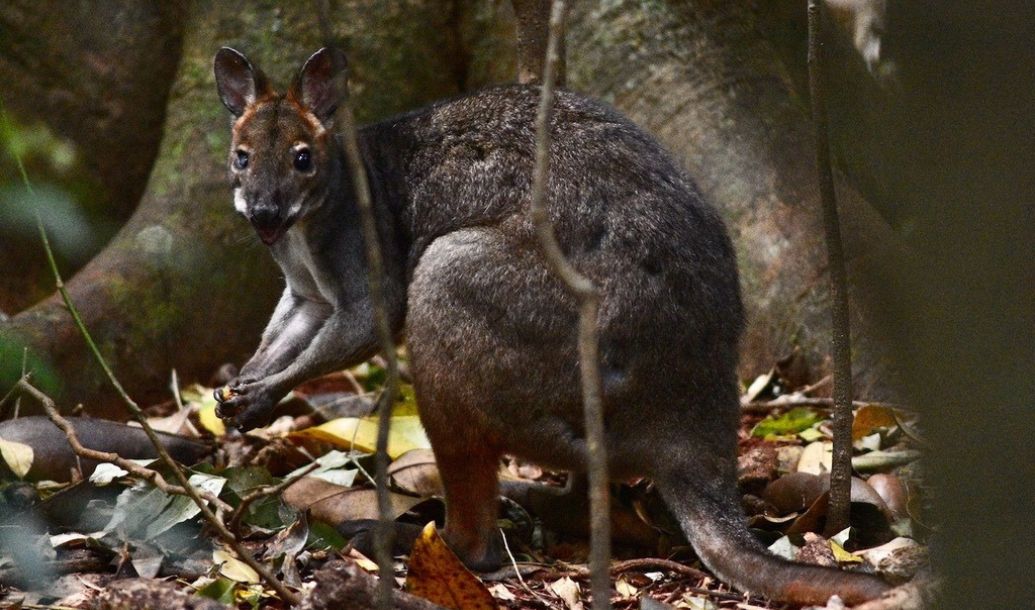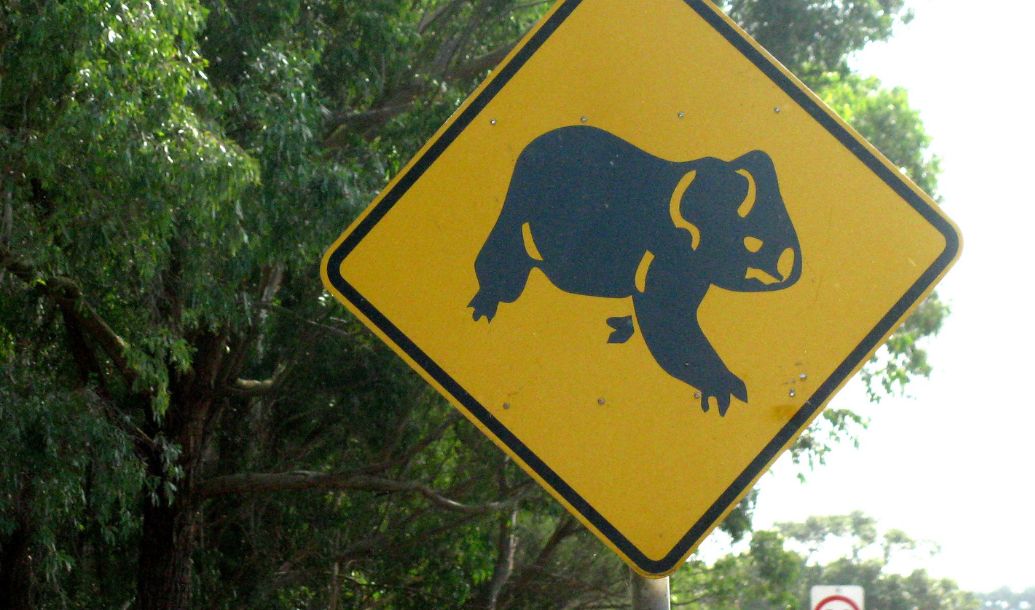The Big Scrub Rainforest Conservancy, landowners, land managers and regenerators have been working hard for 40 years to protect, regenerate and replant the vegetation that once flourished on the red ferrosol soils of the Big Scrub. That vegetation type is lowland subtropical rainforest – a complex and diverse ecosystem that evolved 40 million years ago in the times of Gondwana. An estimated 600 ha have been restored via plantings and natural regeneration. In addition, Big Scrub Rainforest Conservancy cares for around 40 Big Scrub remnants.
Since European settlement the area of lowland rainforest and specifically the Big Scrub has undergone a dramatic reduction due to clearing and in 2011 it was listed by the Commonwealth as a Critically Endangered Ecological Community.
Eucalypt species did not occur in the Big Scrub rainforest. However, currently there are extensive eucalypt plantations being established in the open paddocks of the Big Scrub for koala habitat and carbon sequestration. We understand that more plantations are proposed. These eucalypt plantings are not native to the area, are therefore ecologically inappropriate and will negatively affect the restoration of the Big Scrub rainforest.
Where did the koalas in the Big Scrub come from?
In the 1970s and 80s, macadamia growers planted many kilometres of windbreak trees, primarily Tallowood (Eucalyptus microcorys) which is one of the koala’s primary food trees. This created favourable corridors across farmland within the Big Scrub. At the same time, the then NSW Forestry Commission planted a number of timber plantations, and promoted eucalypt plantings to landholders in the Big Scrub, further attracting koalas.
A major problem arose for the Big Scrub koala in the early 2000s when macadamia plantation management undertook wholesale removal of the Tallowwood windbreaks. Their removal left the vast majority of koalas isolated in the few remaining eucalypt stands with no corridors to allow safe movement. This problem is causing further inbreeding, stress and poor health in these isolated populations.
Bushfires, climate change and koalas
The Black Summer bushfires occurred in 2019-20 taking a terrible toll on koala populations and dramatically raised the awareness of the koala. In February 2022 the koala in Queensland, New South Wales and the ACT was listed as endangered. This listing and the impact of the 2019-20 bushfires has led to a surge in public funding programs and private sector contributions, galvanising government and community support for eucalypt plantings.
This newfound concern for the koala has been supercharged with climate change awareness and the need to plant trees for carbon sequestration. We can now plant eucalypts for koalas and carbon sequestration; sounding like a ‘win win’. The ecologically aware ‘tree changer’ landowners of the Big Scrub particularly hear this message.
Some of these plantings badged as ‘Koala/ Carbon Farming Projects’ on Big Scrub soil have been composed of close to 100% eucalypt species and often come at no cost to the landowner.
Ecological restoration
Rainforest restoration and koala habitat restoration should be based on ecological restoration principles. The guiding principle of ecological restoration is to restore the plants and animal communities that once occurred on the site. The Society for Ecological Restoration states as its first principle: “conservation, repair and renewal of the local native ecosystem”. (SERA, 2018).
Similarly the Koala Habitat Restoration Guidelines (DPE 2022 chapter 4.2.1.) states: “Reference ecosystems will be a specific ecological community, usually dominated by eucalypts, that grows in similar soil, aspect and topographic conditions as the restoration site, and provides primary habitat for koalas”.
Put simply: if there was a rainforest, plant rainforest trees; if there was a eucalyptus forest, plant eucalypts.
Camphor laurel
A major problem with planting eucalypt forests on red soil is they become dominated by camphor laurel, and other woody weed species. Camphor laurel is a major weed in the Big Scrub that has taken over thousands of hectares of pasture and invaded riparian and remnant edges. However, it cannot establish under the low light conditions of rainforest.
A eucalypt plantation, no matter how densely planted or mature, will always allow camphor laurels to establish. See picture below. In the long-term, without concerted management using herbicide or control burning methods, the camphor laurel will dominate the plantation, the eucalypts will die out and the koalas will have no food.

Camphor laurel trees establishing under a eucalypt plantation in the Big Scrub
Future threat of fire
Intense wildfire is a major threat to rainforest remnants that adjoin large eucalypt plantations. Increasing fuel loads in these maturing plantations combined with the more extreme weather conditions as the climate changes is a risk to our Big Scrub remnants and plantings. Are we seeing the emergence of yet another ‘key threatening process’ to our critically endangered Big Scrub rainforest?
The Black Summer bushfires have shown how eucalypt forests/ plantations with a high fuel load can burn into rainforest. Small remnants, fragments and edges are especially vulnerable and have been devastated up and down the east coast.
Big Scrub koalas
What about the plight of the Big Scrub koalas? Aren’t all koalas endangered and deserve help? Or are they genetically isolated, inbred, unhealthy and too close to houses, roads and a high density of domestic dogs? Aren’t these small populations worth saving?
There is no doubt there is a strong push to not only save but also increase the population of koalas in the Big Scrub. It will be difficult to discourage individuals from planting eucalypts especially as they are cheap and often donated to planting projects. But most importantly, everyone loves the cute koala and the simple act of planting a eucalypt to feed a hungry koala is a strong emotional drive. This is a sad reflection on our collective awareness of the other amazing native fauna that rely on the Big Scrub for habitat, like the Pademelon, Quoll and countless varieties of birds and reptiles.

Image credit: rosewise, https://www.inaturalist.org/users/3772292
The Red-legged Pademelon – like the kangaroo and wallaby, a species of macropod – is listed as vulnerable to extinction in NSW.
Is there a planting design that will help the Big Scrub koala and Big Scrub rainforest restoration? Clearly planting 100% eucalypts produces camphor laurel forests with a fire risk and no rainforest. It is also clear Big Scrub koalas need a corridor to link populations and provide a way out of the Big Scrub.
A solution could be to replicate the function of the original eucalypt windbreaks of macadamia plantations. That is to plant narrow corridors, even one tree wide, of eucalypts to allow the movement of koalas through the Big Scrub.
These corridors will need to be strategic and run towards the areas of quality habitat and avoid areas of denser human population and busy roads. This may mean directing koalas towards Goonengerry National Park, Nightcap National Park, Modanville and south of Lismore.
Conclusion
Imagine large-scale, well planned, and fully funded, biodiverse, carbon rainforest restoration plantings being undertaken across the Big Scrub. The good news is, we are seeing some projects with a high standard of ecological integrity underway by progressive landholders and supported by astute carbon brokers and/ or NGOs.
The critical issue is to inform and educate all landowners, government departments and decision makers in all organisations to have a policy of ecological restoration. This means restore all types of our biodiverse ecosystems where they occur naturally, to ensure they survive and thrive into the future.
The resources available for carbon and ecological restoration are only going to increase, so let’s get it right and bring back both the koala and the Big Scrub.
References
‘Department of Planning and Environment Koala Habitat Restoration Guidelines: A practical guide to identify, connect and restore koala habitat in New South Wales’ Environment, Energy and Science, Department of Planning and Environment 2022
Friends of the Koala 2023
https://friendsotkoala.wpengine.com/wp-content/uploads/Koala-Facts-Combined-FINAL.pdf
Standards Reference Group, Society for Ecological Restoration Australasia
https://www.seraustralasia.com/standards/NationalStandards2_2.pdf


